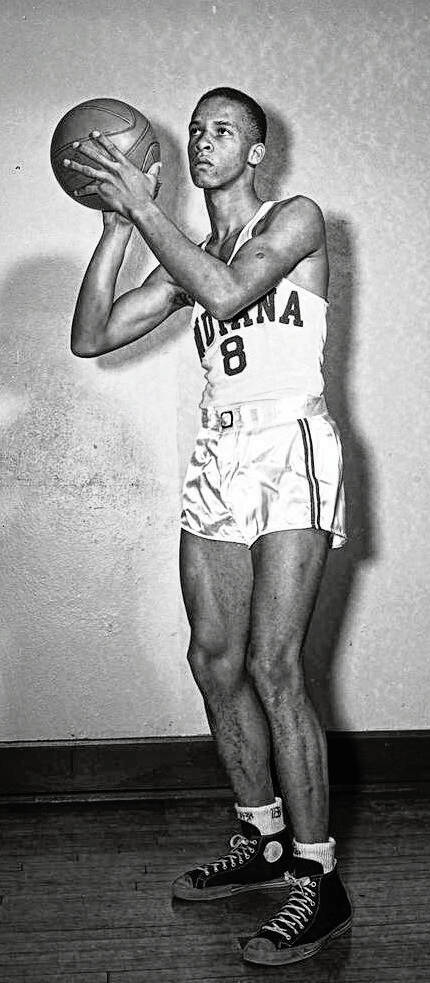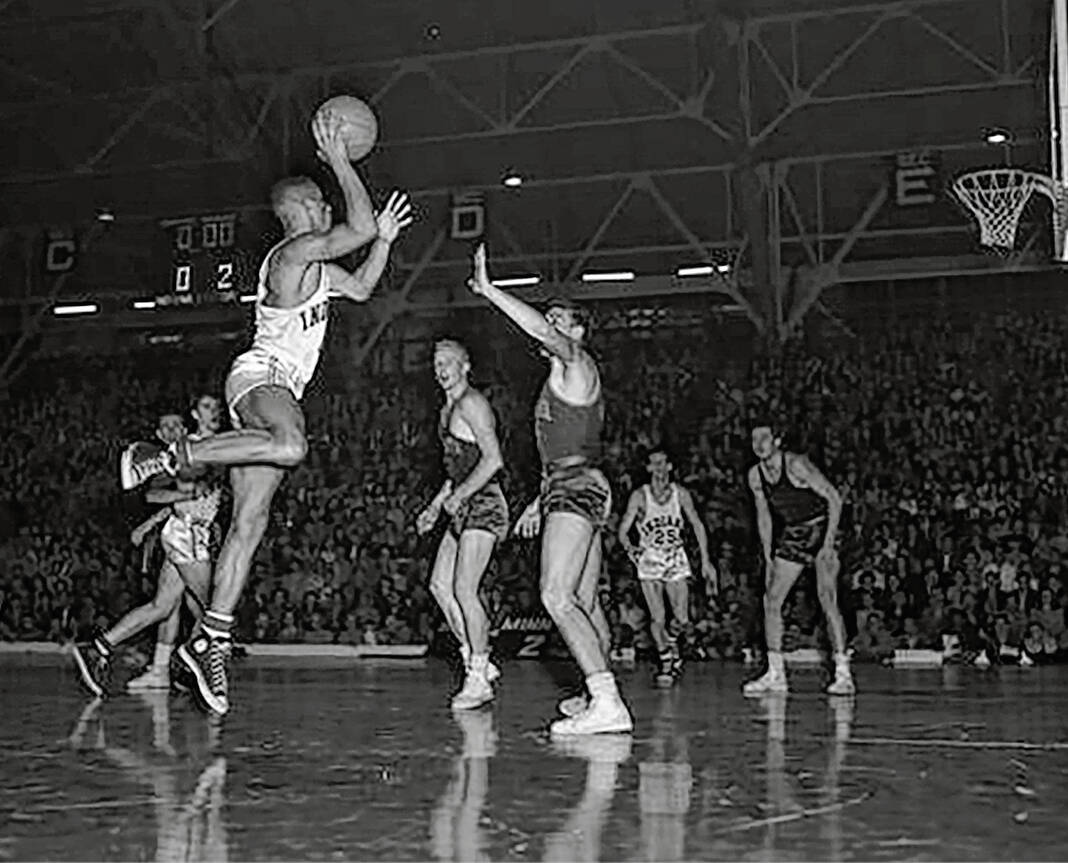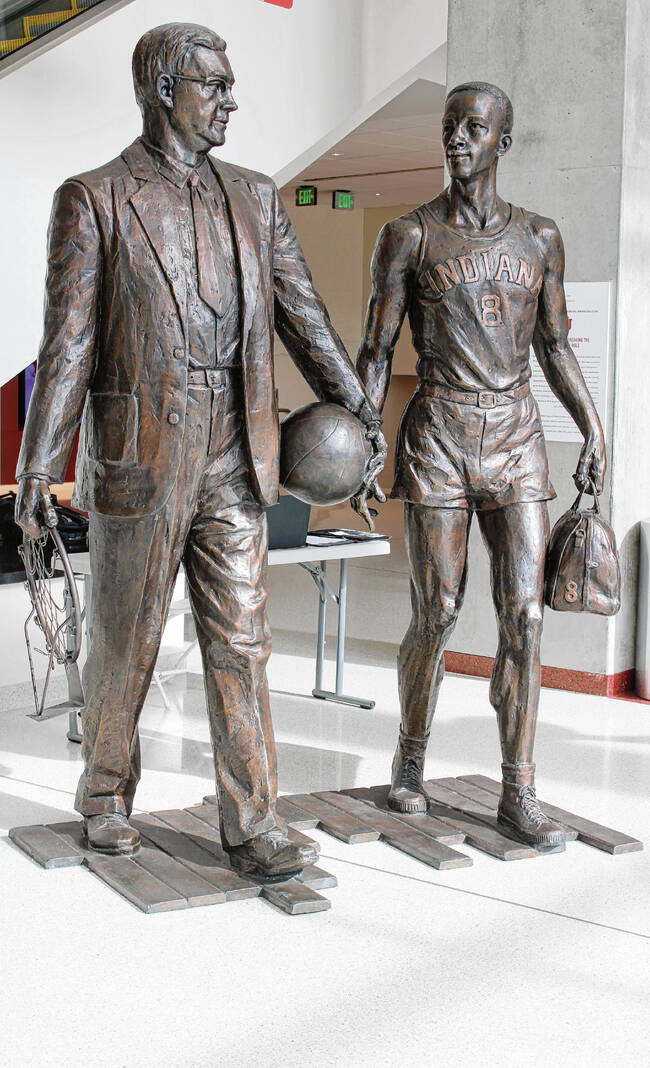
Bill Garrett in an Indiana University publicity shot from his playing days.
Indiana University Athletics

Bill Garrett in action in a game for IU during his 1948-51 All-American career.
Indiana University Athletics
When Indiana hosted its opening game Nov. 7, fans were given programs in the style of those made during Garrett’s college playing days.
Lew Freedman | Aim Media Indiana

Freedman

In the lobby of Assembly Hall, outside the court stands a sculpture-statue of Bill Garrett as a player (right), alongside former IU coach Branch McCracken.
Lew Freedman | Aim Media Indiana
 Freedman
Freedman
BLOOMINGTON — Indiana has named a fieldhouse for Bill Garrett, displays a statue of him in the lobby of Assembly Hall, and the other night as the men’s basketball team began the 2023-24 season, named a game after him.
How different it was in the late 1940s, across America, across Indiana, in Bloomington, when racism was rampant and unconsciously unrepentant, when it was more likely a young Black man like Garrett would be called uncomplimentary names.
Fans attending “The Bill Garrett Game,” gave Garrett’s memory a standing ovation before IU defeated Florida Gulf Coast, 69-63, with 9 family members and friends serving as honorary captains. All shook hands with IU coach Mike Woodson – who is also Black – on the court. They did so on a night when four of the five Hoosiers in the starting lineup were Black.
Just outside the gym door is a striking sculpture of Garrett with famous one-time coach Branch McCracken, representing the road to justice taken together as pioneers. When Bill Garrett arrived in Bloomington from Shelbyville in 1947, he was fortunate to be welcome in everywhere on campus because of his dark skin, never-mind be immortalized in art work.
In 1947, Jackie Robinson integrated Major League Baseball in the 20th century with the Brooklyn Dodgers. He was booed, taunted and had to promise his boss not to fight back at antagonists for two years.
Garrett originally told the Black-oriented Indianapolis Recorder newspaper he wanted to attend IU or Purdue, but might go to UCLA, Southern California, or historically black Tennessee State because the Indiana schools apparently didn’t want him.
He hesitated to become a barrier-breaker, saying, “Too much in the spotlight – suppose I didn’t make good?” Robinson shared those emotions, but persevered. Garrett was reminded Robinson took risks for all Black people and he reconsidered. “That’s right,” he said. “Jackie is preparing the way for others and I guess I could try that, too.”
It took bravery to think that way and face down hatred. In 2017, when a state historical marker was installed on campus recognizing Garrett, he was acknowledged for demonstrating “courage and strength of character in the face of open hostility.” Opposing fans harangued Garrett and he was sometimes prohibited from staying in segregated hotels.
Garrett’s teenaged reticence to tangle with the spotlight was recounted on the back of a four-page program IU handed out at the game. It is a slender pamphlet mimicking the style of those printed when Garrett competed.
It did not hurt Garrett that Black football star George Taliaferro of Gary came to IU in 1945. Taliaferro was not allowed to reside in a dorm and was forbidden from eating in a popular local restaurant. It made Bloomington sound more like Birmingham.
Taliaferro, also appreciated in a statue, outside Memorial Stadium, approached university president Herman B. Wells. Wells called the restaurant owner, who worried his clientele would protest dining with Black students. Wells threatened to put the establishment off-limits to students if an experiment was not tried feeding Taliaferro and others. There were no incidents. Restaurant de-segregated.
Similarly, local activists urged Wells to open the door for Garrett by speaking with McCracken, who explained a so-called “gentleman’s agreement” between Big Ten schools banning Black players.
Garrett, who was Indiana’s Mr. Basketball, and has the Shelbyville gym named for him, was ultimately offered a track scholarship as an entrée to becoming a Hoosier basketball star.
Other Black players had appeared on some Big Ten rosters, but Garrett was the first Black recruit. The long-armed, 6-foot-3 Garrett finished as IU’s all-time scorer, with All-American recognition.
Garrett met his wife Betty at IU and Garrett’s son Bill is an assistant coach at Bethune-Cookman. His grandson Billy Jr. played briefly for the New York Knicks after suiting up for DePaul, and competes in Europe.
The first Bill Garrett was drafted by the Boston Celtics of the NBA, but served in the military before joining the Harlem Globetrotters. Later, he won an Indiana state high school title coaching Crispus Attucks. However, he never saw these Garrett descendants play because he died of a heart attack in 1974 at 45.
Before the IU-Gulf Coast game, as black and white photographs of Garrett showed on the scoreboard, public address announcer Jeremy Gray called Garrett “the most significant basketball player in the history of the Big Ten.”
That was a worthy summation of Garrett’s connection to Indiana University 75 years after coming to campus.
Gazing at a divided United States still coming to grips with racial differences, equanimity remains elusive in 2023. But on his own stage, Bill Garrett’s role was akin to astronaut Neil Armstrong’s description of the moonwalk – one small step for man, one giant leap for mankind.
